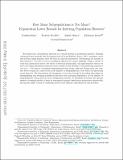| dc.contributor.author | Kim, Younhun | |
| dc.contributor.author | Koehler, Frederic | |
| dc.contributor.author | Moitra, Ankur | |
| dc.contributor.author | Mossel, Elchanan | |
| dc.contributor.author | Ramnarayan, Govind | |
| dc.date.accessioned | 2020-08-31T23:39:41Z | |
| dc.date.available | 2020-08-31T23:39:41Z | |
| dc.date.issued | 2019-04 | |
| dc.identifier.isbn | 9783030170820 | |
| dc.identifier.isbn | 9783030170837 | |
| dc.identifier.issn | 0302-9743 | |
| dc.identifier.issn | 1611-3349 | |
| dc.identifier.uri | https://hdl.handle.net/1721.1/126860 | |
| dc.description.abstract | Reconstruction of population histories is a central problem in population genetics. Existing coalescent-based methods, like the seminal work of Li and Durbin (Nature, 2011), attempt to solve this problem using sequence data but have no rigorous guarantees. Determining the amount of data needed to correctly reconstruct population histories is a major challenge. Using a variety of tools from information theory, the theory of extremal polynomials, and approximation theory, we prove new sharp information-theoretic lower bounds on the problem of reconstructing population structure—the history of multiple subpopulations that merge, split and change sizes over time. Our lower bounds are exponential in the number of subpopulations, even when reconstructing recent histories. We demonstrate the sharpness of our lower bounds by providing algorithms for distinguishing and learning population histories with matching dependence on the number of subpopulations. | en_US |
| dc.description.sponsorship | Office of Naval Research MURI (N00014-16-1-2227) | en_US |
| dc.description.sponsorship | National Science Foundation (Grants CCF1665252, DMS-1737944 and CCF-1565235; Award CCF-1453261) | en_US |
| dc.language.iso | en | |
| dc.publisher | Springer International Publishing | en_US |
| dc.relation.isversionof | http://dx.doi.org/10.1007/978-3-030-17083-7_9 | en_US |
| dc.rights | Creative Commons Attribution-Noncommercial-Share Alike | en_US |
| dc.rights.uri | http://creativecommons.org/licenses/by-nc-sa/4.0/ | en_US |
| dc.source | arXiv | en_US |
| dc.title | How Many Subpopulations Is Too Many?: Exponential Lower Bounds for Inferring Population Histories | en_US |
| dc.type | Book | en_US |
| dc.identifier.citation | Kim, Younhun et al. "How Many Subpopulations Is Too Many?: Exponential Lower Bounds for Inferring Population Histories." International Conference on Research in Computational Molecular Biology, May 2019, Padua Italy, Springer International Publishing, April 2019. © 2019 Springer Nature | en_US |
| dc.contributor.department | Massachusetts Institute of Technology. Computer Science and Artificial Intelligence Laboratory | en_US |
| dc.contributor.department | Massachusetts Institute of Technology. Department of Mathematics | en_US |
| dc.contributor.department | Massachusetts Institute of Technology. Institute for Data, Systems, and Society | en_US |
| dc.eprint.version | Author's final manuscript | en_US |
| dc.type.uri | http://purl.org/eprint/type/ConferencePaper | en_US |
| eprint.status | http://purl.org/eprint/status/NonPeerReviewed | en_US |
| dc.date.updated | 2019-11-15T18:10:59Z | |
| dspace.date.submission | 2019-11-15T18:11:02Z | |
| mit.journal.volume | International Conference on Research in Computational Molecular Biology | en_US |
| mit.metadata.status | Complete | |
